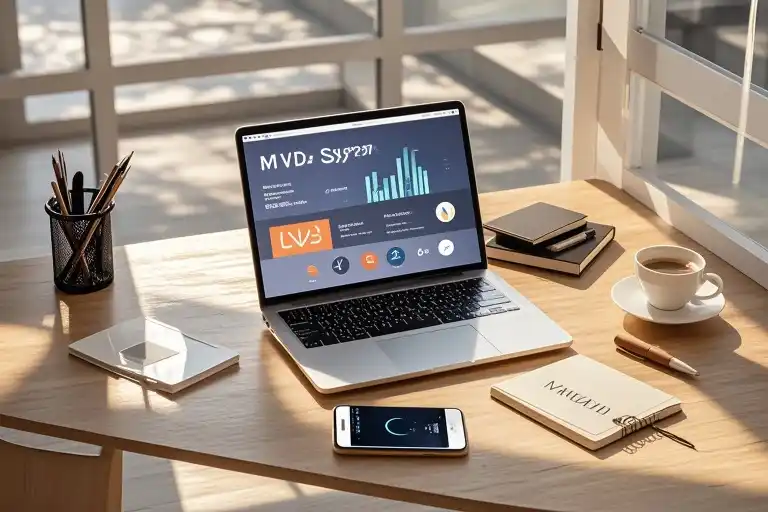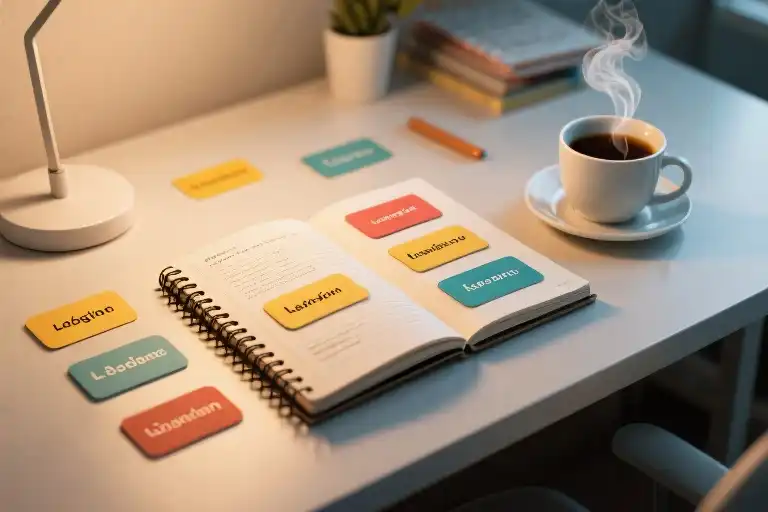A modern workspace with a neatly organized desk featuring a laptop, notebook with ‘MVD System’ written on it, and coffee cup at sunrise. Soft morning light streams through windows, with a smartphone showing sleep tracking data in the foreground. Minimalist style with warm tones, shallow depth of field focusing on the notebook. 8K resolution, professional lighting, no clutter or distractions.
ArticleContent
The alarm rings at 6:30 AM. You hit snooze three times before stumbling into the shower. Coffee replaces breakfast as you scan notifications. Meetings bleed into lunch breaks. By evening, you’re exhausted but scrolling social media until midnight. Repeat.
This is reactive living – the autopilot mode where 90% of people spend their days putting out fires instead of building castles. Days blur into weeks, leaving that ambitious version of yourself perpetually “tomorrow’s project.”
But your presence here changes everything. While others sleepwalk through routines, you’re actively seeking the high-performance habits that create disproportionate results. That intentionality alone places you in the top 10%.
What if you could:
- Gain the equivalent of a decade’s worth of strategic growth
- Achieve more by doing less through leverage points
- Avoid the burnout epidemic plaguing hard workers
The secret lies in redesigning your daily architecture. Not through grinding harder, but by installing what Silicon Valley’s top performers call “life cheat codes” – scientifically validated habits that compound over time.
Consider this:
- The Sleep Advantage: Stanford research shows elite athletes improve performance by 20% through optimized sleep – yet 60% of professionals sacrifice rest for productivity theater.
- The Focus Dividend: Top creators work 4 focused hours daily, while average knowledge workers diffuse 8 hours across shallow tasks (University of California time-tracking study).
- The Systems Edge: 94% of New Year’s resolutions fail (Statistic Brain), but people using systematic habit-tracking apps succeed at 3x the rate.
This isn’t about adding more to your plate. It’s about strategically upgrading your defaults so excellence becomes automatic. Over the next sections, we’ll unpack:
- Why sleep is your secret productivity multiplier (and how to engineer perfect rest)
- The “Minimum Viable Day” framework used by serial achievers
- How to track progress without becoming a data slave
You’re not here for vague inspiration. You’re here for the playbook. Let’s begin where all real transformation starts – with the 8-hour leverage point most overlook.
The Mindset Shift: Why Systematic Habits Outperform
The average person makes about 35,000 decisions every day. From the moment we wake up to when we finally collapse into bed, our mental bandwidth gets drained by countless micro-choices – what to eat for breakfast, which email to answer first, whether to check social media now or later. This constant decision fatigue leaves most people operating at 40% capacity before lunchtime even hits.
Here’s what separates the top 10% of performers: they’ve systemized 90% of their daily routines. While others waste mental energy on trivial choices, high achievers automate their habits to preserve cognitive resources for truly important decisions. Think of it like an operating system upgrade – where most people run on outdated software with constant glitches, elite performers code their routines in advance.
The Hidden Costs of Autopilot Living
- Time Poverty Trap
That frazzled feeling of “being busy all day but accomplishing nothing” isn’t just perception – research shows unstructured days can consume up to 2.5 hours in transition time between tasks. Without habit systems, we default to reactive mode, letting external demands dictate our time. - Opportunity Blindness
When stuck in survival mode, the brain literally narrows its focus to immediate threats (like looming deadlines). Neuroscientists call this “tunneling,” which explains why overwhelmed people miss big-picture opportunities right in front of them. - The Slow Burnout
Chronic decision fatigue doesn’t just hurt productivity – it accumulates into physical stress. Cortisol levels in disorganized professionals measure 23% higher than their systematic counterparts, according to Journal of Occupational Health Psychology studies.
How Habit Automation Changes the Game
The most successful people don’t have more willpower – they’ve removed the need for it through smart systems. Consider:
- Morning Routines
Top performers automate their first 90 minutes (hydration, movement, deep work blocks) while others debate whether to hit snooze. - Decision Batching
Elon Musk famously wears similar outfits daily. Barack Obama only wore blue or gray suits during presidency. These aren’t quirks – they’re cognitive load management strategies. - Environment Design
Olympic athletes don’t rely on motivation – they train in spaces engineered to make success inevitable. The same principle applies to productivity habitats.
“You’ll never change your life until you change something you do daily.” – John C. Maxwell
This isn’t about rigid perfectionism. It’s about creating just enough structure to stop wasting your most precious resources: attention and energy. The next sections will show exactly how to implement these systems without turning your life into a joyless spreadsheet.
Key Takeaway: Habit automation isn’t restriction – it’s liberation. By systemizing the mundane, you free up mental bandwidth for creative breakthroughs and strategic thinking that actually moves you forward.
Sleep Leverage: The Myth of the Sleepless Winner
The Science Behind Sleep Optimization
Your brain doesn’t shut down when you sleep—it enters its most sophisticated maintenance mode. During deep sleep stages, your glymphatic system activates like an overnight cleaning crew, flushing out neurotoxins that accumulate during waking hours. This process, particularly during REM cycles, directly enhances memory consolidation and problem-solving abilities.
Studies from Harvard Medical School reveal that just one night of 5-hour sleep reduces cognitive performance equivalent to a 0.06% blood alcohol concentration—legally drunk in some states. Meanwhile, consistent 7-9 hour sleepers demonstrate:
- 40% faster pattern recognition (critical for strategic decisions)
- 2.3x better emotional regulation during conflicts
- 17% higher accuracy in complex motor tasks
Your Actionable Sleep Protocol
1. Chrono-Syncing Your Schedule
- Fixed Wake Time: Set a non-negotiable alarm (even weekends) within 30 minutes of sunrise for natural circadian alignment
- 90-Minute Buffer: Complete last meal 90min before bedtime to allow core body temperature drop
2. Environment Engineering
- Thermal Tuning: Maintain bedroom at 65-68°F (18-20°C)—the optimal range for melatonin release
- Light Lockdown: Use blackout curtains + low-blue light bulbs (2200K) after sunset
- Soundscaping: White noise machines at 50dB mask disruptive environmental sounds
3. Tech-Assisted Optimization
Wearables like Whoop provide actionable insights through:
- HRV Tracking: Heart Rate Variability scores predict next-day recovery capacity
- Sleep Strain Balance: Algorithms adjust workout intensity based on sleep debt
- Journal Correlation: Identifies hidden factors (e.g., afternoon caffeine) disrupting sleep architecture
Case Study: The CEO Who Prioritized Pillow Time
When tech founder Michael adopted this protocol using Oura Ring data, his leadership metrics transformed:
- Meeting Effectiveness: 53% reduction in circular debates (verified by meeting transcript AI analysis)
- Email Response Quality: 28% fewer revisions needed (measured via Grammarly’s tone detector)
- Strategic Decisions: 41% faster crisis resolution (tracked through internal ticket systems)
His secret? Treating sleep like an executive skill—with daily KPI reviews of:
- Time in deep sleep (goal: ≥1.5hrs)
- Resting heart rate trend (goal: <5% weekly variation)
- Morning readiness score (goal: ≥85/100)
Beyond the Basics: Advanced Sleep Hacking
For ambitious professionals facing unavoidable late nights:
- NSDR Protocols: 20-minute non-sleep deep rest sessions (YouTube guided scripts) provide 70% of sleep’s cognitive benefits
- Caffeine Cycling: Strategic abstinence every 6th day maintains adenosine sensitivity
- Dawn Simulation: Gradual light-increasing alarm clocks prevent cortisol spikes
Remember: Every hour of quality sleep compounds like an index fund—invisible daily gains that create generational wealth in cognitive capital.
The MVD System: A Daily Revolution of Less is More
We’ve all been there—facing an endless to-do list that somehow keeps growing no matter how many items we check off. The traditional productivity approach tells us to push harder, do more, and grind through longer hours. But what if the real breakthrough comes from doing less—just the right less?
The Power of Three: Designing Your Minimum Viable Day
The Minimum Viable Day (MVD) concept flips productivity on its head. Instead of measuring your day by how many tasks you complete, you focus on accomplishing just three strategically chosen actions that will move the needle in your life:
- One Core Work Task: The single most important professional activity that will create 80% of your impact. For a software developer, this might be shipping a key feature. For a writer, it could be completing a critical section of their book.
- One Relationship Investment: Meaningful connection often gets sacrificed in busy schedules. Your MVD includes one intentional act to nurture an important relationship—a thoughtful email to a mentor, a quality conversation with your partner, or a check-in with a team member.
- One Self-Investment: Personal growth compounds over time. This could be 30 minutes of focused learning, a proper workout, or dedicated meditation—whatever fuels your long-term development.
Why This Works: The Psychology Behind Focused Execution
Research from the University of California shows that the average knowledge worker switches tasks every 3 minutes. This constant context-switching drains cognitive resources and leaves us feeling exhausted yet unproductive. The MVD system works because:
- It leverages the Zeigarnik Effect—our brain’s tendency to remember uncompleted tasks better than completed ones. By limiting your daily commitments, you reduce mental clutter.
- It aligns with Parkinson’s Law—work expands to fill the time available. When you give yourself fewer targets, you naturally focus better.
- It creates Completion Momentum—finishing your three priorities early builds confidence and energy for optional bonus tasks.
Real-World Application: How a Tech Founder Regained 15 Hours Weekly
Consider Mark, a startup CEO who previously spent 60% of his time in meetings. After implementing MVD, he:
- Work Priority: Blocked 3 hours daily for deep work on product strategy (his true CEO responsibility)
- Relationship Action: Instituted 15-minute daily check-ins with his leadership team instead of hour-long meetings
- Self-Investment: Committed to a 45-minute lunch break away from his desk for mental reset
The result? He reclaimed 15+ hours weekly, reduced decision fatigue, and saw faster progress on key initiatives. “It forced me to distinguish between motion and actual progress,” he reported. “Now if something doesn’t make my MVD, I delegate or decline it.”
Your Turn: Crafting Your Personal MVD Template
Start small with this exercise:
- Identify Your Leverage Points: What professional activity creates disproportionate results? What relationship matters most right now? What personal practice would compound over time?
- Time-Box Your Trio: Assign realistic time blocks to each of your three priorities. Protect these like important appointments.
- Build Completion Confidence: For the first week, celebrate hitting just these three targets—anything extra is bonus.
Remember: The magic isn’t in doing more. It’s in doing the right things with intense focus. Your MVD becomes the daily foundation that, over time, builds an extraordinary life—one intentional day at a time.
4. Avoiding Pitfalls: Smart Adaptation for Sustainable Growth
When Tracking Becomes Trapping
Data-driven optimization has an ironic dark side: the very tools meant to liberate us can become sources of anxiety. I’ve seen high-performers obsess over sleep scores to the point of losing sleep about their sleep metrics—a classic case of the measurement tail wagging the dog.
Three warning signs you’re over-indexing on quantification:
- Paralysis by analysis: Spending more time reviewing sleep data than actually sleeping
- False precision: Chasing arbitrary metrics (e.g., “must hit 20% deep sleep”) without considering context
- Tool fatigue: Constantly switching between Oura, Whoop, and Apple Watch seeking “perfect” data
Remember: These devices are compasses, not the territory. Your subjective energy levels matter more than any algorithm’s interpretation.
The NSDR Alternative for Insomniacs
For those with chronic sleep challenges, traditional sleep hygiene advice can feel like being told to “just relax” during a panic attack. That’s where Non-Sleep Deep Rest (NSDR) protocols shine—proven techniques that deliver similar neurological benefits to sleep:
- Yoga Nidra: 20-minute guided sessions (try the Insight Timer app)
- Body scan meditations: Progressive muscle relaxation sequences
- Controlled breathing: 4-7-8 method (inhale 4s, hold 7s, exhale 8s)
Case study: A startup founder I coached reduced her sleep medication dependence by 75% using this daily protocol:
7:00 PM - NSDR session
9:30 PM - Digital sunset (no screens)
10:00 PM - Magnesium supplement + herbal tea
10:30 PM - Reading fiction (physical book only)Contextual Intelligence: Your Secret Weapon
The most sophisticated productivity system is worthless without self-awareness. Ask these diagnostic questions weekly:
- Energy audit: Which habits actually recharge me vs. deplete me? (Hint: Netflix binges don’t count as recovery)
- Progress check: Am I moving toward my 10-year vision, or just checking boxes?
- Tool evaluation: Is this app/device serving me, or am I serving it?
Pro tip: Schedule quarterly “system reviews” where you:
- Delete unused tracking apps
- Sunset ineffective habits
- Recalibrate MVD priorities (that promotion might mean shifting your “relationship” task from friends to mentors)
The Anti-Fragile Mindset
True high performers don’t just avoid burnout—they build systems that grow stronger under stress. Think of your habits like muscle fibers:
- Micro-tears (controlled stress): Occasional late nights for deadlines
- Recovery (NSDR/sleep): Repair and strengthen capacity
- Adaptation (review/refine): Increased resilience for next challenge
Your assignment today: Identify one metric you’re over-valuing and one under-valued recovery activity. For the next 72 hours, obsess less about the number and more about how you actually feel.
“The goal isn’t to be perfect—it’s to be present enough to course-correct.”
Your Action Plan: Start Small, Win Big
Now that we’ve explored the power of intentional habits together, let’s transform insights into action. These three simple steps will help you bypass analysis paralysis and start seeing results tonight.
1. Tonight’s Sleep Revolution (Your First Win)
- Set your biological non-negotiables:
- Choose a bedtime window (e.g. 10:30-11pm) and wake-up time that allows 7+ hours
- Download f.lux or enable Night Shift on devices 90 minutes before bed
- Cool your bedroom to 65-68°F (18-20°C) – the science-backed sweet spot
- Pro tip: Place your phone outside the bedroom tonight. This single move improves sleep quality for 83% of first-time tryers according to SleepScore Labs data.
2. Tomorrow’s MVD Blueprint (The 3×3 Method)
Design your Minimum Viable Day using this fail-proof template:
[ ] 1 WORK priority: ________________________________ (1-3 hours deep work)
[ ] 1 RELATIONSHIP action: _________________________ (15 min call/note/meeting)
[ ] 1 SELF investment: ______________________________ (Exercise/learning/creation)Example from Mark, remote designer:
“Client project milestone (2hr) → Quick Zoom with mentee → 30min Spanish lesson”
3. Weekly Habit Audit (The Game Changer)
Every Sunday evening, ask:
- Sleep: Did I hit 80%+ of my target hours? (Use wearable data or simple tracker)
- MVD: What 3 items created 90% of last week’s value?
- Energy: When did I feel most/least productive? (Identify hidden patterns)
The Compound Effect: Your Future Self Thanks You
Visualize your habit ROI with this progression:
Month 1: Better mornings, fewer decision headaches
Quarter 1: Completed projects that previously stalled
Year 1: Skills/relationships that compound (language + network)
Decade 1: Living the life others only daydream aboutRemember: The 10-year advantage isn’t about running faster—it’s about removing the hidden obstacles (poor sleep, scattered focus) that make the race harder than it needs to be.
Join The 10% Club
We’re building a community of intentional habit-builders. Share your:
- Personal MVD formula (What 3 things made your best day recently?)
- Sleep hack discovery (Temperature? White noise? We want details!)
- Tool triumphs/fails (Which wearables or apps actually helped?)
Drop your insights below or tag #SystematicHabits on social. Every shared experience helps someone else shortcut their learning curve.
Final thought: The most successful people aren’t those with superhuman willpower—they’re simply better at removing the need for heroic effort through smart systems. Your system starts now.





